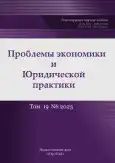Drivers of Changes in the Interest Rate Environment in the United States
- Autores: Medzhidov M.1
-
Afiliações:
- Moscow University for Industry and Finance «Synergy»
- Edição: Volume 19, Nº 6 (2023)
- Páginas: 163-169
- Seção: Economic Theory
- URL: https://journals.rcsi.science/2541-8025/article/view/252475
- EDN: https://elibrary.ru/OMGZYB
- ID: 252475
Citar
Resumo
In this article, we investigate the contribution of the drivers of changes in the interest rate environment over time in the US economy. Principal Component Analysis (PCA) is often used in the world with interest rates. It rotates the original dataset linearly so that the modified dataset is orthogonal and better represents variation within the dataset. It has proven itself to be a powerful statistical method in the field of yield curve analysis. PCA-based time structure models usually provide an accurate fit to observed returns and explain most of fluctuations. Although the main components are the building blocks of modern time structure models, this approach has been less studied for risk modeling. Interest rate risk models are usually difficult to define and evaluate due to the changing modes of profitability and volatility. In this article, we combine estimates of conditional volatility of the main components within the framework of quantile regression (QREG) to derive estimates of the profitability of the distribution. This study will be conducted based on the historical values of the US curve, starting in 2006. Also, the decomposition of changes in yields at different durations and relative to changes in different shapes is presented.
Palavras-chave
Texto integral
##article.viewOnOriginalSite##Sobre autores
Mikail Medzhidov
Moscow University for Industry and Finance «Synergy»
Autor responsável pela correspondência
Email: Mikayil.majidov@gmail.com
Código SPIN: 3122-8846
Scopus Author ID: 1228207
Master of Finance
Rússia, MoscowBibliografia
- Vartanova M. L. Eurasian Economic Union: dynamics and trends of economic development in the context of growing macroeconomic uncertainty // Greater Eurasia: development, security, cooperation. —2022. —№. 5-1. —Pp. 382–385.
- Hajiyev M. M., Sharich E. E., Yakovleva D. D. Mutual funds as the basis of the collective investment market and drivers of economic growth // UEPS: management, economics, politics, sociology. —2019. —№. 3. —Pp. 72–81.
- Zolina S. A., Kopytin I. A., Reznikova O. B. «Shale Revolution» in the United States as the main driver of restructuring the world oil market // Contours of global transformations: politics, economy, law. —2019. —V. 12. —№. 6. —P. 71–93.
- Herzekovich, D. A. Choosing priority areas of investment in stock markets according to the «Profitability-risk» model/ D. A. Herzekovich // Economics and entrepreneurship. —2018. —№ 9 (98). —Pp. 673–680.
- Sharpe, W. F. Investments: Translated from English / William F. Sharp, Gordon J. Alexander, Jeffrey V. Bailey. —M.: INFRA-M: NFPC NTF», 1997. —X, 1024 p.
- Markowits, H. M. Portfolio Selection / H. M. Markowits // Journal of Finance. —1952. —№ 1. —pp. 71–91.
Arquivos suplementares

















